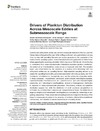Identificador persistente para citar o vincular este elemento:
https://accedacris.ulpgc.es/jspui/handle/10553/74376
| Título: | Drivers of Plankton Distribution Across Mesoscale Eddies at Submesoscale Range | Autores/as: | Hernández-Hernández, Nauzet Arístegui, Javier Montero, María F. Velasco-Senovilla, Esther Baltar, Federico Marrero-Díaz, Ángeles Martínez-Marrero, Antonio Rodríguez-Santana, Ángel |
Clasificación UNESCO: | 2510 Oceanografía | Palabras clave: | Canary Islands Eddies Eddy Pumping Frontogenesis Mesoscale-Submesoscale Interactions, et al. |
Fecha de publicación: | 2020 | Proyectos: | Remolinos Oceanicos y de Posición Atmosferica (Roda): Dinámica y Monitorización de Remolinos Oceanicos en la Corriente de Canarias Estudios de la Bomba Vertical Oceánica en Remolinos de Mesoscala Flujos de Carbono en Un Sistema de Afloramiento Costero (Cabo Blanco, Nw de Africa). Papel Del Carbono Disuelto y en Suspension en El Contexto de la Bomba Biologica. Tropical and South Atlantic - climate-based marine ecosystem prediction for sustainable management |
Publicación seriada: | Frontiers in Marine Science | Resumen: | Cyclonic and anticyclonic eddies are common mesoscale features in the flow past the Canary Islands throughout the year. While drifting southward, eddy pairs interact among them but also with upwelling filaments and eddies generated at the coastal jet of the nearby African upwelling system. These interactions force the generation of frontal zones where ageostrophic secondary circulation (ASC) may occur. With the aim of contributing to understand how meso-submesoscale interactions modulate plankton distribution, we carried out an interdisciplinary cruise across a mesoscale eddy field. The sampled region was characterized by the presence of a cyclonic eddy interacting with two anticyclonic eddies and an upwelling filament. High-resolution sampling allowed us to assess the upwelling/downwelling processes associated with eddy pumping and ASC, the injection of nutrients into the euphotic zone, and the subduction of particles related to these processes. The planktonic community, which included heterotrophic bacteria, cyanobacteria-like Prochlorococcus and Synechococcus, pico and nanoautotrophic eukaryotes, and heterotrophic nanoflagellates, showed a heterogeneous distribution in response to meso-submesoscale processes. Redundancy analysis and plankton distribution suggest that while the distribution of small organisms (picoplankton) is modulated by a combination of physical and biogeochemical drivers, the distribution of larger autotrophic and heterotrophic nanoflagellates is modulated by nutrient inputs and grazing, respectively. These observational results provide new insights in the study of the impact of mesoscale structures in the dynamics of nutrients, chlorophyll and planktonic communities, and valuable to validate theoretical and modeling studies. | URI: | https://accedacris.ulpgc.es/handle/10553/74376 | DOI: | 10.3389/fmars.2020.00667 | Fuente: | Frontiers in Marine Science [EISSN 2296-7745], v. 7, (Agosto 2020) |
| Colección: | Artículos |
Citas SCOPUSTM
22
actualizado el 08-jun-2025
Citas de WEB OF SCIENCETM
Citations
21
actualizado el 08-jun-2025
Visitas 5
224
actualizado el 31-oct-2024
Descargas
173
actualizado el 31-oct-2024
Google ScholarTM
Verifica
Altmetric
Comparte
Exporta metadatos
Los elementos en ULPGC accedaCRIS están protegidos por derechos de autor con todos los derechos reservados, a menos que se indique lo contrario.
